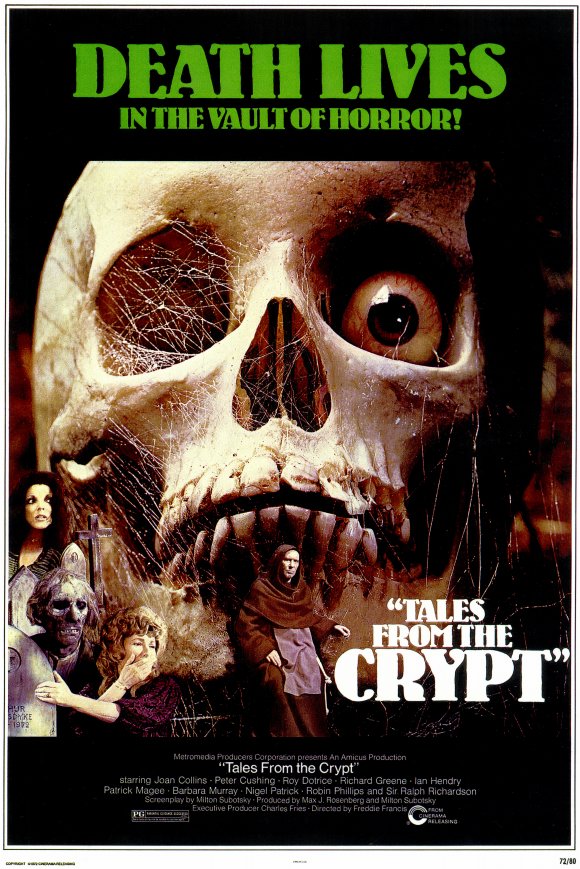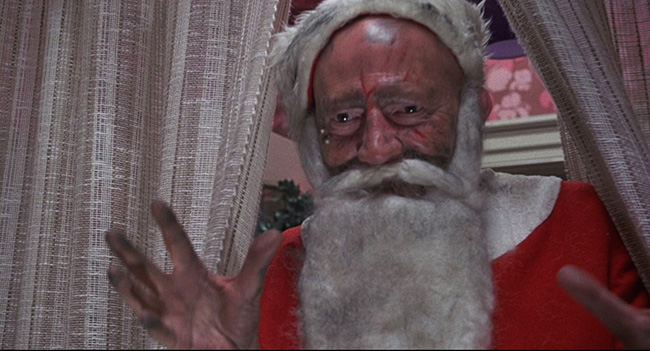
Amicus Productions, the British film company launched by Americans Milton Subotsky and Max Rosenberg, found its niche with the horror anthology: Dr. Terror’s House of Horrors (1964), Torture Garden (1967), The House That Dripped Blood (1970), and Asylum (1972) among them. Subotsky was a professed fan of the classic British anthology Dead of Night (1945), and admired how the film was able to skip from one chilling tale to the next without any story overstaying its welcome. Arguably, the studio’s run in this format reached its apex with Tales from the Crypt (1972), the first of two EC Comics adaptations (the second, Vault of Horror, arrived a year later). Freddie Francis, the Academy Award-winning cinematographer who also directed British horror films (including Hammer’s Paranoiac, Evil of Frankenstein, and Dracula Has Risen from the Grave), had become a reliable staple at Amicus with movies like Dr. Terror’s House of Horrors, The Skull (1965), and The Deadly Bees (1966), and was the obvious choice for Tales from the Crypt. The cast was filled out with the expected array of British horror stars and recognizable character actors, led by distinguished stage and film actor Sir Ralph Richardson (Dragonslayer) and notably including Joan Collins and the always-reliable Peter Cushing. American International Pictures co-funded and the film was a major hit.
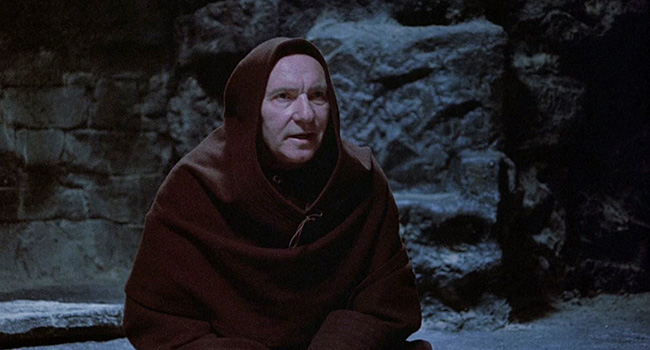
Ralph Richardson as the Crypt Keeper.
The fact that it is a British film set in England provides a slightly unusual take on the uniquely American source material, later realized, with a greater pop culture impact, in a long-running HBO series. EC Comics (the “E” was for “Entertaining”), under publisher William Gaines, became notorious for its publication of boundary-pushing comic books in the late 40’s and early 50’s including Tales from the Crypt, The Vault of Horror, The Haunt of Fear, Shock SuspenStories, and Weird Science. The explicitly gruesome morality plays of its horror titles and other edgy content helped fuel a conservative crusade against comic books, led in part by Fredric Wertham’s diatribe Seduction of the Innocent and a U.S. Congressional inquiry, and with the institution of the Comics Code Authority and its strict standards which held sway over what titles retailers would be willing to carry, Gaines reluctantly folded the majority of his titles, and eventually found a new niche with humor magazines including Mad. But Tales from the Crypt and its ghoulish ilk – each led by a different horror host, the Crypt Keeper, the Vault Keeper, and the Old Witch – held a special place in the heart of comic readers exposed to EC at an impressionable age, and the banned label lent the comics the appeal of forbidden fruit for those who never had the opportunity to discover them in the first place. Therefore Subotsky’s decision to adapt EC for their next anthology was inspired; after all, their earlier horror films, several of which were written by Psycho author Robert Bloch, already had a strong flavor of EC. The transition to a British setting, and the presentation of a very different Crypt Keeper (Richardson in a hooded cloak), only become slightly distracting for EC fans as the macabre, grisly stories themselves take center stage, all based on stories from Tales from the Crypt, The Haunt of Fear and The Vault of Horror.
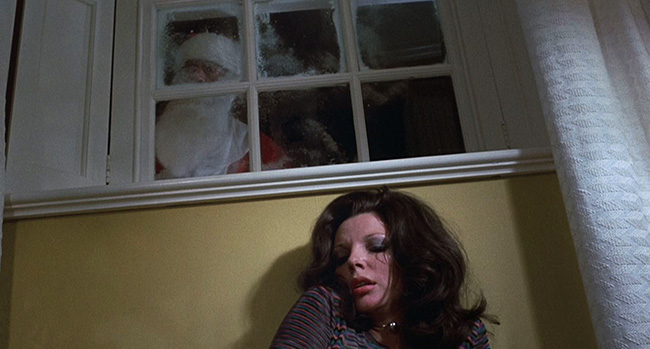
Joan Collins hides from a psychopath Santa in “…And All Through the House.”
Members of a tour of ancient catacombs find themselves sealed in a subterranean chamber with the Crypt Keeper. He prompts a vision in each of them. For Collins’ Joanne Clayton, it’s the story “…And All Through the House,” based on a Vault of Horror story later adapted by Robert Zemeckis for the first season of the HBO series. Joanne murders her husband on Christmas Eve while her daughter sleeps upstairs. This is realized in the best shot of the film: the gentleman sits down in the living room while “O Come Let Us Adore Him” plays on the radio; he unfolds a newspaper which obscures his face, there’s a heavy crunching noise, and blood suddenly stains the newsprint from the opposite side. The paper drops to reveal Joanne standing above his body and holding a bloodstained poker. She grabs the keys to open the safe and review the life insurance policy. “Mummy! Mummy!” cries her daughter from upstairs. “Mummy will be with you in a moment, darling,” she says, and goes to clean the blood off the poker. Outside lurks a psychopath in a Santa suit – a radio announcement interrupts a stream of Christmas carols to explain that a homicidal maniac has escaped from the local hospital for the criminally insane. And so, while Joanne tries to clean up the murder scene and take care of her daughter – too anxious to sleep with Christmas just a few hours away – she also finds herself fending off a home invasion from the deranged Santa. It’s a classic horror story that’s presented well here, right down to its nasty twist ending, though one wonders why someone as ruthless as Collins’ character doesn’t take advantage of the situation and at least attempt to make the murder scene look like the maniac’s work; instead, she determinedly keeps cleaning up while the man is at her door…
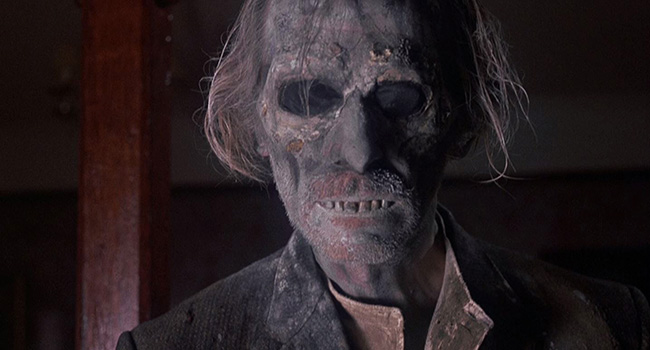
Zombie Peter Cushing in “Poetic Justice.”
More Crypt Keeper-fueled visions haunt his trapped guests. The weakest is “Reflection of Death,” with a cheating husband (Ian Hendry, Repulsion) getting into a car accident with his mistress; the film switches into first-person as he stumbles back to his home, wondering why everyone reacts with terror when they see him – until he catches his own horrifying reflection. This twist is followed quickly by another, though it only escalates the simple story into absurdity. Much better is “Poetic Justice,” featuring a memorable performance by Cushing as a gentle old man, Arthur Grimsdyke, living with a number of dogs and a favorite of the local children. The downright evil father-and-son neighbors stage an elaborate campaign to expel this lower-class man from their neighborhood, including having his dogs rounded up and removed and spreading rumors to make sure parents never let their kids near him again. The final straw is a series of nasty forged Valentines telling Grimsdyke how much he’s hated (in rhyme), and he’s compelled to hang himself. But he returns to exact his revenge. “Wish You Were Here,” starring Richard Greene (The Hound of the Baskervilles) and Barbara Murray, twists the old “Monkey’s Paw” story by self-consciously referencing it, then watching as the knowing characters humorously fall straight into the same old trap anyway. In the last segment, “Blind Alleys,” we visit a home for the blind run like a gulag by the heartless Major William Rogers (Nigel Patrick, The League of Gentlemen). His insensitivity to the needs of his residents leads to clashes with the grim-faced George Carter (Patrick Magee, A Clockwork Orange). Finally Carter and his fellows imprison Rogers and force him to squeeze through a tight corridor lined with razor blades while pursued by his own dog, driven to the brink of starvation and hungry for his flesh.
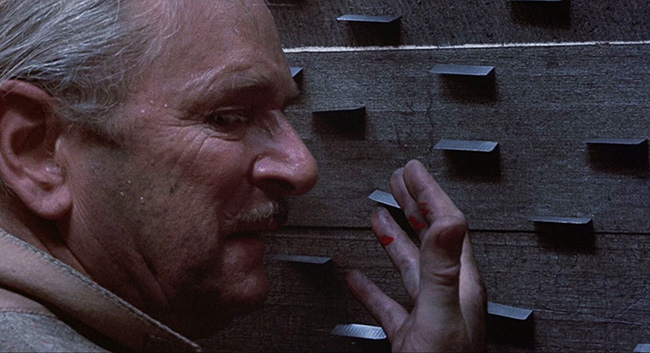
Major Rogers (Nigel Patrick) endures a razor blade-lined corridor in “Blind Alleys.”
It says something for Tales from the Crypt that its first and last stories are likely to stick with you for a very long time. The slowburning “Blind Alleys” in particular is a triumph of this kind of storytelling, building anticipation for its central villain to get his comeuppance while making it perfectly clear, through Magee’s perfect casting, that his opponent will go to any lengths to teach him a lesson. Though considerably less serious, “…And All Through the House” is holiday horror at its finest, subverting Santa Claus mythology more than a decade ahead of Silent Night, Deadly Night (1984). The ultimate fate of the Crypt Keeper’s guests is obvious from the start, but that hardly matters; the kitsch ending simply drives home that the murder and mayhem have all been in good fun. Vault of Horror (1973), directed by Roy Ward Baker (Quatermass and the Pit), would be not just a sequel but a virtual clone, with another cast of British character actors (including Tom Baker and Denholm Elliott) trapped in another room recounting more EC-inspired stories of their gruesome demises. It’s an enjoyable film, but with a less successful hit-to-miss ratio. Scream Factory appropriately paired the films for its definitive Blu-ray release, thankfully resurrecting the uncut Vault of Horror (a pointlessly censored version had been the more common home video incarnation). The discs are essential for horror anthology fans.
